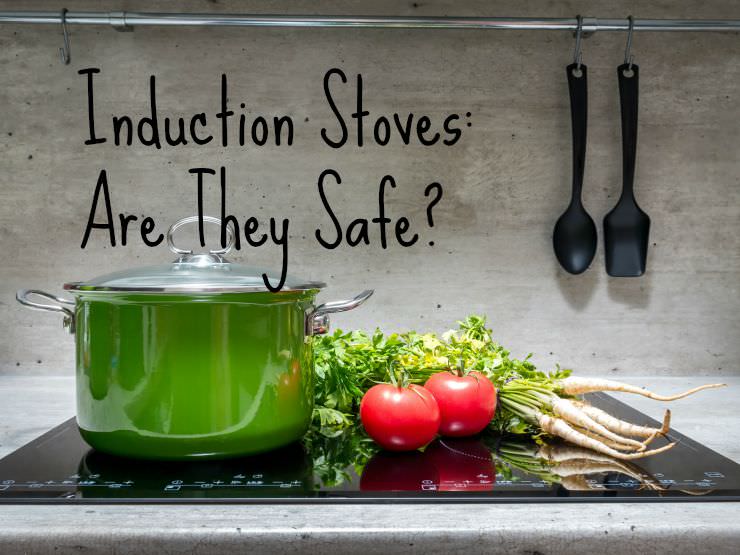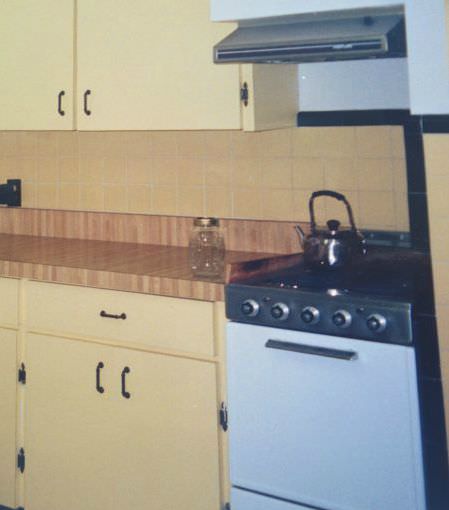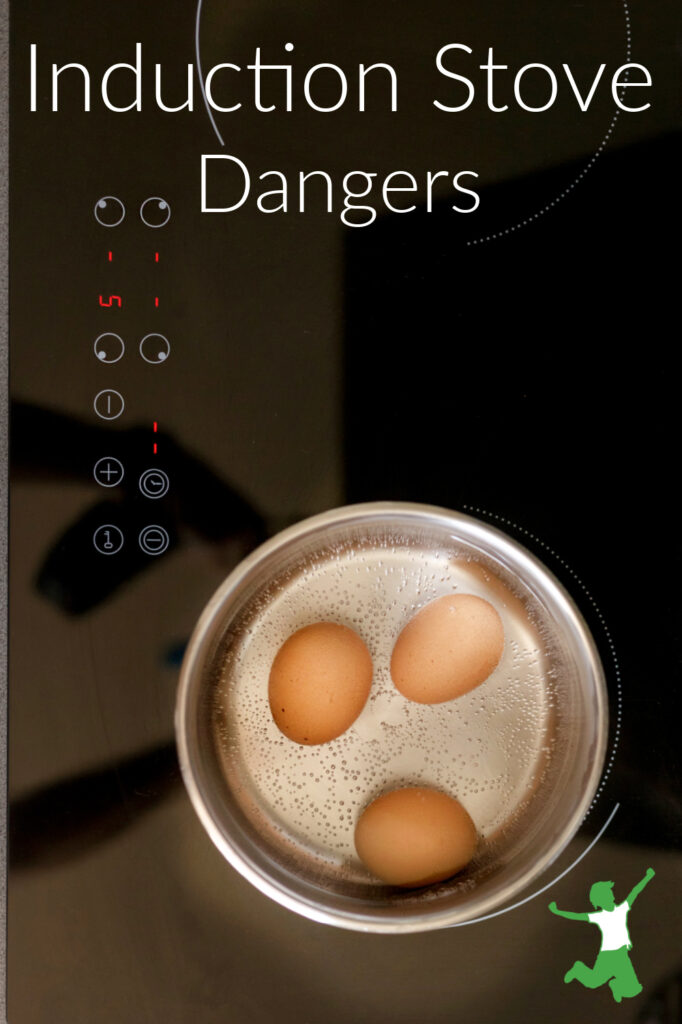The important reasons why bringing an induction stove into your home should be approached with caution as this technology is a source of excessive EMF toxicity as confirmed by scientific study. Even induction stove user manuals warn against standing too close!

Buying a kitchen stove is a rare purchase most people make only a few times in a lifetime. Currently, the trend toward replacing electric cooktops with an induction stove is quite popular. Is this a wise purchase? Let’s take a look …
In our home, we purchased a glass top stove in 1997 when we completely remodeled the (very old) kitchen. At that time, the range we selected boasted the latest and greatest technology which included a glass top cooking surface.
We were upgrading from a tiny 1950’s stove (see hilarious picture below) that while it seemed to fit very well with the orange, 1970s style wallpaper, fake butcher block countertops and canary yellow cabinets (no kidding), it was not something we regretted replacing!
While this new range was awesome (so nice not to have to clean up messes under coil burners anymore!) and has served us well for many years, it recently came time to replace it when problems developed.
Induction, Gas or Electric?
Since we had upgraded to the best technology many years earlier with good results, we thought we should probably do so again. This involved the purchase of an induction stove with all the bells and whistles. The upgrade hopefully would make my many hours spent in the kitchen even more efficient.

Since indoor air-polluting gas stoves were thankfully not an option for our neighborhood, electric was our only choice. We made the rounds to Best Buy, Home Depot, and online to see what was available.
We eventually settled on a stainless steel induction stove. It offered nearly all the latest technology of the (amazing but ridiculously expensive) Viking stoves that celebrity chefs use but with a much more reasonable price tag.
This is the induction stove we originally picked that thankfully, we never bought (we bought this one instead).
I particularly liked the extra-large knobs and oversized glass top that prevented spills from trickling down the crack between the stove and the countertop. It was exactly what I was looking for.
We also decided to get the matching convection oven (that also functions as a toaster) to replace our old microwave oven that I only ever used for storage anyway.
Little Known Dangers of an Induction Stove
Really excited about our upcoming purchase, I posted about it on social media to see if anyone had any further input.
Right away, a couple of comments got my attention.
Jeanette K. said, “My mother’s induction stove was measured by EMF professionals and had extreme readings.”
In addition, Beth H. warned that “The only downfall [with an induction stove] is that you have to use pans that magnets can stick to”.
EMF Risks?
So glad I asked for the input! Neither of these concerns about induction stoves was mentioned by the salespeople I spoke to or the marketing material I had reviewed.
Since I frequently cook with glass, having to only use pans that magnets can stick to would be a serious downside.
It would require purchase of a few pieces of new cookware and bakeware which I really didn’t want or need.
But, it was Jeanette’s comment about the EMF dangers of an induction stove that really gave me pause. EMF overexposure is a huge concern of mine that I’ve written many articles about.
We take great pains in our home to minimize excessive EMF exposure such as turning off wifi at night, using radiation canceling cases and headsets for our cellphones, and EMF shields for our PCs and notebooks.
I also avoid dirty electricity in our home by never using dimmer switches, fluorescent, or LED bulbs.
In addition, we use battery power for our electronics as much as possible. Higher EMF exposure occurs when you use a laptop while it is plugged in, for example.
Induction Technology Emits Strong Magnetic Fields
When I started examining the technology behind an induction stove, I was more than a little shocked and incredibly grateful Jeanette had commented about it to clue me in to do further research. Here’s what I found out:
The technology of an induction stove works by alternating magnetic fields that generate heat in a cooking vessel made of ferrous metals. The benefits of induction cooking as opposed to thermal heating with a traditional stovetop include up to 50% faster and more even cooking of the food and slightly reduced energy usage.
Parents of young children like it because the coil itself underneath the glass stovetop doesn’t actually get hot. This means the cooking surface stays cool and won’t burn little hands or steam up if you spill liquid on it.
While it is extremely controversial whether this type of radiation source is actually dangerous, the data is sufficient enough for me to avoid it.
The latest information I found that should give anyone pause about bringing an induction stove into their home was published by the Journal Bioelectromagnetics in 2012. (1)
The study authors concluded that most induction hobs (rings) exceeded even the high 1998 maximum exposure levels set by the International Commission on Non-Ionizing Radiation Protection (ICNIRP) when a person was standing close to the induction stove.
The worst-case scenario was an up to 16-fold increase from these maximum exposure levels!
Safety Tests
So how in the world did induction stoves ever pass the safety tests?
According to Powerwatch, the safety tests assumed that a person’s body is never closer than 1 foot (30 cm) to the front of the induction stove. Standing that far away would be considered “normal usage”.
I don’t know about you, but I don’t cook standing at least a foot away from my stove. My arms definitely aren’t long enough!
In fact, this would be pretty much impossible if you needed to reach the back burners.
Don’t Use a Microwave? You Won’t Want Induction Either
The bottom line is that if you avoid microwaved food and microwaves in general, you will want to pass on the induction stove as it uses similar technology.
I’ve not used a microwave in 25 years (and not missed it for a second, I might add). Why would I start now exposing myself and my family to potentially dangerous, concentrated sources of EMFs with an induction stove which works in a similar fashion?
Of course, induction stove manufacturers insist the technology is safe.
They claim that the radiation hazard dissipates within a few inches to a foot of the appliance. “Normal usage” would not expose a person to a radiation hazard.
Right?
I’ll pass thanks.
Safer Alternatives
Fortunately, the exact same stove I wanted was available in a traditional, thermally based cooktop without an induction feature. This is the case with all the induction ranges I examined in fact!
This is the stainless steel electric stove model we eventually bought. We’ve had it for several years now and continue to love it! As a bonus, it much more easily fit within our budget than the unsafe induction models!
Sometimes the latest and greatest isn’t always the best or even the safest.

References
(1) Exposure of the human body to professional and domestic induction cooktops compared to the basic restrictions
(2) Powerwatch: In Your Home. EMF Cooking Safety
(3) Induction stove user manual
More Information
Are Pressure Cookers Safe (and do they form MSG in food?)
Clay Pots for Safe Cooking
10 Tips for Using Stainless Steel Cookware Safely
Fitbit Health Concerns (particularly while you sleep!)
Are AMR Devices Safer than Smart Meters?
Heavy Metal Toxicity Raises Risk of EMF Sensitivity
Reducing Exposure to Dirty Electricity
The Health Hazards of Wireless Baby Monitors
Harvard MD Speaks Out about the Health Dangers of Smart Meters
Protect Yourself from a Smart Meter








How about the food itself ? Is the food cooked using induction cookware dangerous ?
I don’t believe so … the food should be fine.
Hello,but if I get close to the induction just for few seconds to switch it off,still anyway dangerous?
Anyway the cooked food is safe?
Thank you
I’m wondering if you have done any research on infrared cooking? I’m trying to find an alternative for heating up my food at work but in reading your article i don’t want to use induction. There are infrared portable cookers that I’m hoping will work.
Sarah, I see that you stated that you did not care for gas. I’d like to know why. I am wondering if it is because of the fumes that it creates in a home. We just purchased a house and I was so excited that there was a gas stove already installed because my husband had told me how much better you can cook with one. However, after digging into the topic I am concerned that I am contaminating my air quality and poisoning my family as I cook a lot! (and I already don’t have good ventilation) I have three little ones and definitely do not want to affect their lungs. How does this negative compare with the EMFs from an electric stove?
Is anyone discussing about induction effect on food we cook on it ? Our raw food also as traces of metals like iron, copper etc in it. I think It will be more harmful if we consider this point.
I think induction burners are cost-effective than gas ranges. If we want to save the planet, we should opt energy-efficient burners like induction ranges.
Induction stoves are highly dangerous to health and only minimally better on the energy efficiency. Not worth the tradeoff!
I Think that’s more of a personal attitude for who never used it. I don’t personally fancy gas. As such induction proves to be the best in class when compared to other technologies I also had. Of course there are cheap induction hobs and decent units from major manufacturers. Don’t expect the cheap, non brand units to comply with all norms. This is true in many other things in life.
As to cookware, nowadays most stuff seems to already support induction. Might be an issue for those that have the kitchen already established. When we bought our home, over 10 years ago, we just started with induction stuff and never looked back.
EMI is a problem if unregulated, but every day we walk outside and breathe cancerous fumes emitted by road vehicles. Check the latest VW scandal. What did the EU do? Well they plan to reduce emission standards and allow cars to pollute twice as much now!
My point is, such as with anything, just because some cheap models didn’t comply and were above the legal limits, it doesn’t mean we should condemn the technology, but rather shop wisely. There’s being cautious and being paranoid…
Do you have any links for studies that show induction cooking is unsafe? Not emf in general – induction cooking?
See the link in the article that you need to stand at least one foot away from an induction stove for it to be “safe”. This is what is assumed by the manufacturer. I don’t know about you, but I don’t have arms that long.
Thank you for this information! Can anyone comment on if this would apply to the infrared radiant space heaters, too, such as a under desk or wall mount? I can’t find much on the safety? Any thoughts are appreciated! Thank you.
I think those are relatively safe except for any fire hazard potentially.
My dad bought an induction hob, & suffered terrible pain in his head each time he used it, so he threw it out.
Hi Sarah;
Your new stove looks gorgeous! I am getting a new stove very soon, because of EMF sensitivities. We currently have electric and the clock/control panel is on the front. Hate to burst your bubble, but that control panel puts out a big electromagnetic field. If you have a gauss meter it is very easy to measure. We have a fairly good gauss meter we purchased for only $50 or so. It is also fairly easy to make your own meter to measure electric fields across the body. But the gauss meter was enough proof for me to stay far away from that clock. Even the switches on an electric stove put off a field when the associated burner is on.
I don’t sleep with an electric clock near my head and so was concerned about cooking with a clock so close to my reproductive and other abdominal organs. EMF’s cause early miscarriage, according to Ann Louise Gittelman, so it really concerned me, as I have a history of this. Too bad you can’t have a gas stove in your area. I am currently standing to the side of the stove and using back burners until ny new gas range arrives, one with the controls and clock on the back.
Happy (and safe) Cooking!
I also don’t want to pop your bubble but it’s not because it’s a gaz stove that it is automatically safer.
articles.latimes.com/2013/nov/06/science/la-sci-sn-gas-stoves-air-pollution-california-20131106
Since moving in with my elderly parents to care for them last December, I’ve been cooking on their induction stove, which is about 20 years old now. At least, it’s a glass-topped stove with radiant elements that look like your second stove photo, not the first. And the cooktop most definitely gets hot, and even after you turn the “burners” off, red lights indicate a hot surface. I don’t find it faster than a gas stove by any means, but I’m stuck with it. I tend to turn the burners off earlier than I might with gas and finish cooking with the considerable residual heat. I’ve gotten used to cooking with it.
Most stainless-steel pans work just fine on an induction or glass cooktop. I’ve never used glass on a stove; can’t imagine why I’d need to, or why you’d need new bakeware for an electric oven attached to an induction cooktop.
I’m not entirely convinced about the radiation dangers, but I suppose it’s always a good idea to reduce EMF exposure just as a precaution. I don’t find that I need to stand closer than a foot away anyway. This seems like a bit a fear-mongering to come up with a new blog post.
That doesn’t sound like an induction stove … just because it’s glass top doesn’t mean its induction.
Sarah,
You have been my go to person if I have any questions on food. I have followed all your recommendations and feel great at 74. Like you I was unaware of dangers of induction cooking when I got a single induction burner to make boon broth. I have a gas stove with a pilot and was concerned about all night cooking and not being able to continuing adjustment in temp to gain maximum gelatin.
Some times no gelatin. I plug my single burner in a upstairs room and set the temp at 190 degrees F
And forget about it for as long as I want. The gelatin is thick and yummy every time with beef or chicken (I put all the other ingredients you suggest as well) I am not recommending the unit just a thought to consider.
Thank You for all that you do.
Gilbert